
Prepared for: Employment and Social Development Canada
Contract Number: G9547-130012/001/CY
PWGSC-issued POR number: 034-13
Award date: 2013-10-30
Final end-of-field date: November 20th, 2013
Delivery date: December 9th, 2013
Prepared by:
Ipsos Reid Public Affairs
One Nicholas Street, Suite 1400
Ottawa ON K1N 7B7
Tel: 613.241.5802
Fax: 613.241.5460
www.ipsos.ca
Ce rapport est aussi disponible en français sur demande.
For more information on this report, please e-mail: nc-por-rop-gd@hrsdc-rhdcc.gc.ca
© 2013 Ipsos Reid. All rights reserved.
Contains Ipsos’ Confidential, Trade Secret and Proprietary Information.
For the past three years, the Government of Canada has aired the successful Better Jobs ad campaign with the objective of raising awareness among Canadian youth of key government programs and services that could help them obtain the education and skills they need to get better jobs.
Budget 2013 includes new measures related to skills and training. Building off the success of the Better Jobs campaign, ESDC’s new Skills Initiative campaign will:
ESDC identified a need to conduct qualitative research in order to pre-test creative materials flowing from the new ESDC Skills Initiative campaign.
The goal of the creative testing was to determine whether the creative treatment resonates with the target audience and meets the advertising campaign’s objectives (specific objectives will be included in a project briefing with the selected supplier) and to determine what changes, if any, are needed in the creative. Pre-testing the creative elements of the advertising campaign will be critical to the success of the overall campaign.
More specifically qualitative research focused on the following elements:
Ipsos-Reid conducted a series of 8 focus groups in Halifax, Quebec City, Brampton1 and Red Deer with members of the general public. Two groups conducted in each location. Focus groups in Halifax, Brampton and Red Deer were conducted in English; Quebec City focus groups were in French. All focus group attendees were between 18 and 54 years of age. In addition, screening questions were used to ensure a good mix of gender, academic attainment among participants in all sessions. Furthermore, the recruitment screener included questions designed to ensure that all those recruited were fully capable of participating in focus group discussions.
Prior to commencement of focus groups, participants were required to produce a piece of government issued photo ID in order to verify their identity and eligibility to participate in focus group sessions. In addition, all participants were informed of Ipsos Reid’s intent to videotape and audiotape sessions and asked to sign a written consent form authorizing the use of video and audio taping. Focus group participants were reminded of the purpose of the research, the study sponsor and Ipsos Reid’s mandate to carry out the research. All participants were reminded that their participation in this study was voluntary and that any and all input collected during the course of the focus groups would remain confidential.
All those having participated in the sessions received a 75$ honorarium as a token of appreciation for their participation.
Of note: Ipsos Reid rotated order of presentation of creative concepts tested from one location to the other in order to control for any response bias.
Total expenditures (invoiced by supplier): $45,032.79
All focus group sessions were conducted between November 14th and November 20th, 2013.
| Location | Audience | Date |
|---|---|---|
| Halifax | General Public 18-54 years of age | November 14th |
| Quebec City (French) |
General Public 18-54 years of age | November 18th |
| Brampton | General Public 18-54 years of age | November 19th |
| Red Deer | General Public 18-54 years of age | November 20th |
Note to Reader
Qualitative data from focus group discussions are reviewed by the researchers, who draw out continuities and synthesize the main themes, critical "hot buttons", "typical" responses and general levels of agreement/disagreement voiced during the sessions. The analysis of qualitative findings yields tendencies and indications of how the target audience perceives the study issues. However, results are not representative of the general population. Qualitative research involves a limited number of people who are specially selected according to pre-determined attributes. Only quantitative surveys that have a robust number of respondents who have been selected randomly from the target population can be generalized as to represent the broader population.
I hereby certify as Senior Officer of Ipsos Reid that the deliverables fully comply with the Government of Canada political neutrality requirements outlined in the Communications Policy of the Government of Canada and Procedures for Planning and Contracting Public Opinion Research. Specifically, the deliverables do not include information on electoral voting intentions, political party preferences, and standings with the electorate or ratings of the performance of a political party or its leaders.

Marc Beaudoin
Vice President
Ipsos Reid Public Affairs
Initially participants were asked what they felt was the single most important issue currently facing the country today and deserving of the federal government’s attention. Participant feedback can be grouped into three broad themes:
In terms of the economy, concern focussed on personal and public debt levels. Comments tended to focus on jobs and unemployment, affordability of housing, and interest rates. A few noted an apparent disconnect between recently reported number of jobs created and what they have witnessed in their day to day lives. The consensus among group participants was that increased efforts needed to be put into creating ‘good jobs’ or ‘skilled jobs’ rather than low paying and part time jobs.
A number of participants were of the view that more ‘good job’ options were needed for those entering the workforce, as well as in particular regions (notably the Atlantic provinces). There were also references to employment insurance, and how the recent rule changes have led to added strains on certain families.
References to the environment were generally framed in the context of the importance of balancing our economic and environmental interests; specifically the importance of ensuring resource extraction was done in an environmentally responsible way. Other major areas of concern included health care, the social and economic impacts of an aging population and sustainability of the current housing market to name a few.
When asked what was heard about job creation or skills development, a few made references to the Economic Action Plan and seemingly the ‘Better Jobs’ ads – but few mentioned anything beyond that.

While most participants conceded that the scenario presented in this ad could have relatively broad appeal, it was seen as being primarily intended for those recently unemployed, those considering a change in career paths/ employment retraining as well as immigrants and for some, specifically men.
Indeed, a few female participants – particularly those more literal felt this concept could potentially have limited appeal among female viewers, as the scenario presented highlighted what could be interpreted as a predominantly male-centric career (electrician).
Focus group participants in all sessions characterize this concept as ‘relatable’. The use of a real life testimonial approach was seen as effective in capturing viewers’ attention and making the audience more sympathetic to the situation being presented. A number of participants described this scenario as realistic, a situation most anyone could find themselves in – some stating that ‘an average Joe’ losing his job is an everyday story – it’s not farfetched or unlikely.
Participants with whom the ad resonated generally agreed that it was important to have a testimonial from a ‘real’ person rather than an actor, to add weight and impact to the message. By doing so this would make the audience more sympathetic to his/her individual situation knowing a real person has gone through this situation and was able to get financial assistance and support. It also adds credibility to the intent of the programs being advertised.
The possibility of obtaining $4000 in grants was well received – many participants retained this information. For these individuals, it added to the impact and weight of the message – the concept provided a concrete demonstration of the kind of support that is available through such programs, and further conveyed that the Government offers assistance to those who need it, and are willing to retrain.
For many the underlying theme here was hope – not only for those having lost their jobs, but for those who, even in later stages of life, may be considering making a change or pursuing a career rather than simply holding down a job. It offered encouragement that anyone can improve their job situation if they seek the proper available resources.
Many also liked this concept for the clarity and directness of the message – it was to the point – laid off, retrained, re-hired in a better job. It was seen as very matter-of-fact.
Participants stated that they would be most likely to share this information or discuss the ad with someone they knew who was in the same situation – particularly those who just lost their job, or those whose skills are outdated.
Those for whom this concept was less appealing were less likely to say they felt compelled by the emotional, ‘story’ angle. It had particularly limited appeal for certain groups – an unlikely scenario for youth to find themselves in (losing job after several years or needing to retrain), and as mentioned earlier, less likely to resonate with women due to its perceived focus on the trades.
Overall there was an apparent dichotomy in feedback received; some felt the target was narrow in scope: male, immigrant, older; while others felt it was inclusive due to the ‘Average Joe’ nature of the situation.
A few key elements in terms of content stuck with participants. The use of the phrase “stumbling upon” in the copy suggested a lack of user-friendliness of the website, and information retrieval that would likely have more to do with luck than ease of access or intuitive searches. A few said this further reinforced existing perceptions of government websites in general. Some suggested that the website appear for longer so it can be retained, while others simply wanted some clear ‘tags’ or keywords to make it easier to do a general or Google search later on to find the information.
Also, while mention of the $4000 in grants was generally well received, it also led some to reflect on the actual costs of retraining and more specifically, how potentially insignificant this amount could be relative to the total cost of retraining.
Again, while many received the real-life testimonial positively, for others it went counter to what they would expect from the Federal Government: expecting ads with more information and facts, first and foremost. For some, it raised more questions: What kind of jobs does this apply to? What kind of eligibility criteria must you meet in order to get assistance? Is $4000 the maximum amount available?
The pace at which information was presented and delivered in this concept was also problematic for some – a few participants in each session mentioned information overload saying they were unable to process and retain all information presented to them.
Finally, due to the perception that this concept is more limited in scope (focus on trades), some felt that it would likely require multiple executions in order to appeal to a broader audience. Indeed, being able to see oneself in this particular situation, to a certain extent, determined personal relevance and subsequently, interest finding out more.
Participants in all sessions agreed that the message was clear and direct - the Federal Government provides information on various programs available to assist those interested in retraining. The call to action was also clear – the scenario illustrated that assistance is available, and encourages viewers to find out more by visiting the website. Again, the tone of the advertisement was seen to be hopeful, encouraging, and informative.

This concept is seen as having broad appeal (all ages and groups, including youth, those currently unemployed, as well as those considering a career change). Unlike the other two ads, this concept is not seen to be gender, ethnicity or age-specific. The focus on statistics and salaries was effective in capturing viewers’ attention. In addition the range of white-collared and blue-collared jobs, made this concept relevant to a broad audience - regardless of age, ethnicity, and employment status.
Whereas concepts #1 and concepts #3 were deemed to be lacking in facts and figures, concept #2 was more in line with what participants expected of Government of Canada advertisements. The reference to job numbers and salary expectations effectively captured viewers’ attention – piquing their interest, encouraging them to reflect on the possibilities, and to consult the website for further information. The salary information was particularly compelling for those more factual, and quantifying the demand for certain jobs gave the impression that there are better jobs out there to be filled. Participants added that this concept with its reference to facts and figures could be effective as conversation-starter.
It was generally understood that the careers presented were meant to provide a range of examples rather than simply limited to those presented on screen – further contributing to perceptions of broader appeal. The range of white-collared and blue-collared jobs presented was appreciated, although a few female participants expressed concern that occupations presented were male-centric. However, most were able to extrapolate beyond the examples of occupations provided, and concluded that if opportunities were present in these fields, that there were likely opportunities in related areas as well.
The phrase “people need jobs, jobs need people” was retained by many and deemed to be an effective hook, as individuals often said that it gave the impression that the Government is attempting to help bridge the gap between labour demand and supply.
The pace and amount of information presented was problematic for many. A number of participants stated that they had a difficult time retaining/recalling all the information presented, with too much information being communicated in a short time.
Another source of expressed frustration often mentioned was the difficulty in reconciling visual information presented on screen along with the narration. This led some participants to feel overwhelmed, unable to concentrate fully, or retain much of the information presented.
Furthermore, some participants questioned the accuracy of the facts and figures presented. Most failed to notice that these numbers reflected a projection over the next 10 years, rather than current figures. This oversight was generally attributed to the pace at which information was being presented, and the fact that different information was being presented both visually and verbally. Moreover, participants in all sessions felt it was important to underscore that numbers presented were based on projections.
A few, particularly in Halifax, wanted to know where these jobs would be. These individuals were quite skeptical that many would be found in the Atlantic provinces.
The message in this concept was also very clear: the Government provides information on various programs and job opportunities to assist job seekers. The call to action ultimately was to visit the website, which was understood – however some also simply took it as a reminder to start looking at what’s out there.

This concept is seen to target aboriginals and youth first and foremost – particularly at the outset of the ad. A few participants mentioned that they ‘checked out’, thinking that the ad and programs referenced were targeted to Aboriginals only.
Few strengths were identified in this concept. While there is little ambiguity as to whom is targeted (aboriginals and youth), and sponsorship is clear, viewers found this concept to be the least compelling of the three presented.
While this ad did effectively communicate that there are programs available for youth and aboriginals, it was seen as relevant only to them, offering otherwise limited information. There was much confusion as to the purpose of the ad beyond job programs for the aboriginal community. Few could surmise as to what they were expected to do with the information – given that they felt it was not targeted at them.
There was also no strong call to action: viewers did not feel compelled to seek more information as a result of viewing the ad. Again, given they did not find it to be personally relevant or compelling, the general reaction was: ‘so what?’
Like the first concept, this concept was also seen to be focused on the trades – further limiting its appeal to a broader audience.
Finally, while some felt that too much information was presented, others felt that the ad was too general or vague – offering little information of value. As a result, few retained specific information or a specific message after viewing it.
There was no consensus on the intended message, and overall the ad caused much confusion. A few said they would look for more information simply to see what the ad was about.
| Date | Time | Location |
|---|---|---|
| Nov 14, 2013 | 5:30 pm – Group #1 7:30 pm – Group #2 |
Halifax, N.S. Corporate Research Associates 7071 Bayers Road, Suite 5001 |
| Nov 18, 2013 | 5:30 pm – Group #1 7:30 pm – Group #2 |
Quebec SOM Recherche 3340 rue de la Pérade 4 étage (Salle de Groupe) |
| Nov 19, 2013 | 5:30 pm – Group #1 7:30 pm – Group #2 ALL RECRUITS MUST LIVE IN BRAMPTON |
Brampton, ON Infoquest Research 6655 Kitimat Rd, Unit 12 (Mississauga) |
| Nov 20, 2013 | 5:30 pm – Group #1 7:30 pm – Group #2 |
Red Deer Sheraton Red Deer 3310 50 Ave Room : TBA |
Hello/Bonjour, my name is ______________. I'm calling from Ipsos Reid, a national public opinion research firm. On behalf of the Government of Canada we’re organizing a series of discussion groups to explore various issues of importance to the country.
EXPLAIN FOCUS GROUPS. About ten people like you will be taking part, all of them randomly recruited just like you. For their time, participants will receive an honorarium of $85. But before we invite you to attend, we need to ask you a few questions to ensure that we get a good mix and variety of people. May I ask you a few questions?
Your participation is voluntary. We are interested in hearing your opinions, no attempt will be made to sell you anything or change your point of view. The format is a “round table” discussion led by a research professional. All opinions expressed will remain anonymous and views will be grouped together to ensure no particular individual can be identified.
1) Do you or any member of your household work in or has retired from:
IF “YES” TO ANY OF THE ABOVE, THANK AND TERMINATE
2) Are you a Canadian citizen between 18 and 54 years of age old who normally resides in the [XX] area?
2b) How long have you lived in [INSERT LOCATION]?_______
[TERMINATE IF LESS THAN 2 YEARS]
3) Have you ever attended a consumer group discussion, an interview or survey which was arranged in advance and for which you received a sum of money?
4) How long ago was it?
[TERMINATE IF IN THE PAST 6 MONTHS]
5) How many consumer discussion groups have you attended in the past 5 years?
TERMINATE IF MORE THAN 4 GROUPS]
6) Could you please tell me what age category you fall in to? Are you...
7) Could you please tell me what is the highest level of education that you have completed? [ENSURE GOOD MIX PER GROUP]
8) What is your current employment status? [ENSURE A GOOD MIX PER GROUP]
9) [IF EMPLOYED/RETIRED] What is/was your current/past occupation? __________________________ (PLEASE SPECIFY)
10) Which of the following categories best describes your annual household income? That is, the total annual income before taxes – or gross income – of all persons in your household combined? [ENSURE A GOOD MIX IN ALL GROUPS]
11) DO NOT ASK – NOTE GENDER [ENSURE 50-50 SPLIT]
12) If you could be a superhero, what superpower would you want to have? Why? (MUST BE ABLE TO PARTICIPATE, I.E. PROVIDE A RESPONSE AND EXPLANATION. TERMINATE IF FLIPPANT, COMBATIVE OR EXHIBITS DIFFICULTY IN RESPONDING)
TERMINATE IF RESPONDENT OFFERS ANY REASON SUCH AS SIGHT OR HEARING PROBLEM, A WRITTEN OR VERBAL LANGUAGE PROBLEM, A CONCERN WITH NOT BEING ABLE TO COMMUNICATE EFFECTIVELY OR IF YOU HAVE A CONCERN.
Wonderful, you qualify to participate in one of our discussion sessions. Is there anything in particular that we can do to accommodate your participation in the session? [Prompt with: do you have any special needs? i.e. accessibility issues]
The session will be 2 hrs in length. We are reserving this discussion time for you. So if for any reason you cannot attend, please call: XXX-XXXX. We may be reviewing certain print materials AND listening to some audio recordings so if need be please bring along your glasses.
| Date | Time | Location |
|---|---|---|
| Nov 14, 2013 | 5:30 pm – Group #1 7:30 pm – Group #2 |
Halifax, N.S. Corporate Research Associates 7071 Bayers Road, Suite 5001 |
| Nov 18, 2013 | 5:30 pm – Group #1 7:30 pm – Group #2 |
Quebec SOM Recherche 3340 rue de la Pérade 4 étage (Salle de Groupe) |
| Nov 19, 2013 | 5:30 pm – Group #1 7:30 pm – Group #2 ALL RECRUITS MUST LIVE IN BRAMPTON |
Brampton, ON Infoquest Research 6655 Kitimat Rd, Unit 12 (Mississauga) |
| Nov 20, 2013 | 5:30 pm – Group #1 7:30 pm – Group #2 |
Red Deer Sheraton Red Deer 3310 50 Ave Room : TBA |
Explain to participants:
MODERATOR – RANDOMIZE ORDERING OF CONCEPTS FROM ONE GROUP TO THE NEXT– REPEAT LINE OF QUESTIONING BELOW FOR EACH .
MODERATOR: REMIND PARTICIPANTS THAT THESE ARE CONCEPTUAL RENDERINGS, NOT FINISHED ADS, WILL NOT BE ANIMATION WILL BE REAL PEOPLE, NOT LOOKING FOR ART CRITIQUES RATHER REACTIONS TO THE IDEAS/MESSAGES THAT ARE BEING COMMUNICATED.
HAND OUT QUESTIONNAIRE AND HAVE PARTICIPANTS COMPLETE PRIOR TO DISCUSSION.
BROAD VIEWS OF ADVERTISEMENT:
To start with I'll be presenting 3 ad concepts about jobs and training.. After having shown you each advertisement concept, I would like you to complete a short questionnaire based on this ad. I’ll be handing out a short questionnaire for each ad before we open up the floor in order to discuss each treatment individually [PLAY ADVERTISEMENT] – MODERATOR ALLOWS A FEW MINUTES TO COMPLETE QUESTIONNAIRE FOR EACH CONCEPT PRESENTED – REMEMBER TO WALK PARTICIPANTS THROUGH QUESTIONNAIRE.
MODERATOR REPEATS LINE OF QUESTIONING FOR ALTERNATE CONCEPTS.
OK, NOW I’M GOING TO SHOW YOU/HAVE YOU LISTEN TO ANOTHER POSSIBLE CONCEPT AND I’D LIKE US TO COMPLETE THE SAME EXERCISE AS WE JUST HAVE.
TAGLINE AND TERMINOLOGY TESTING (20 MINUTES)
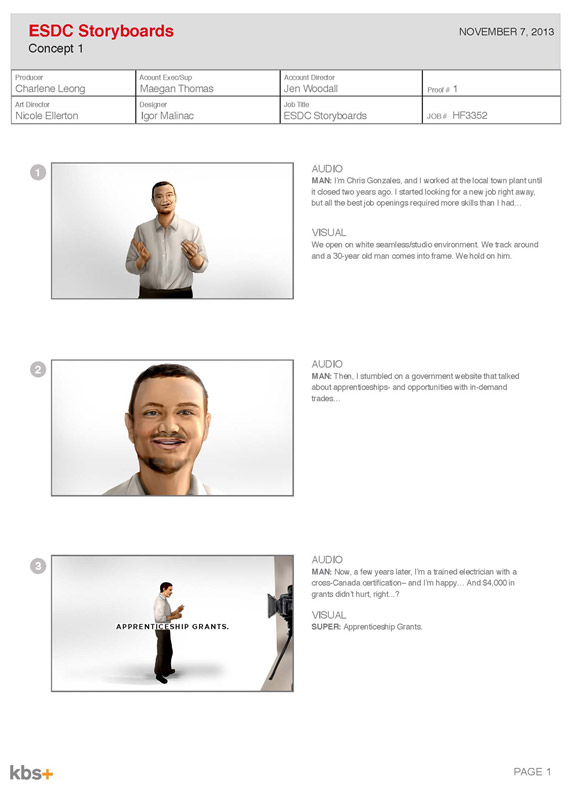
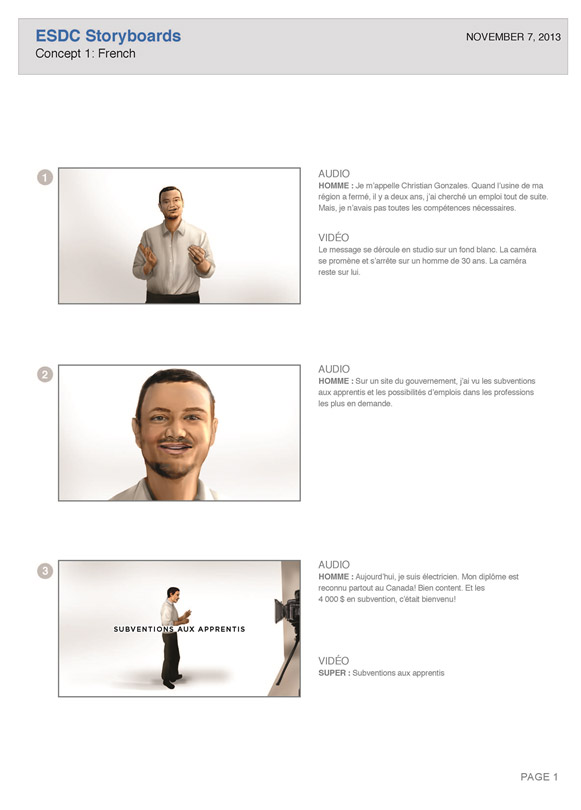
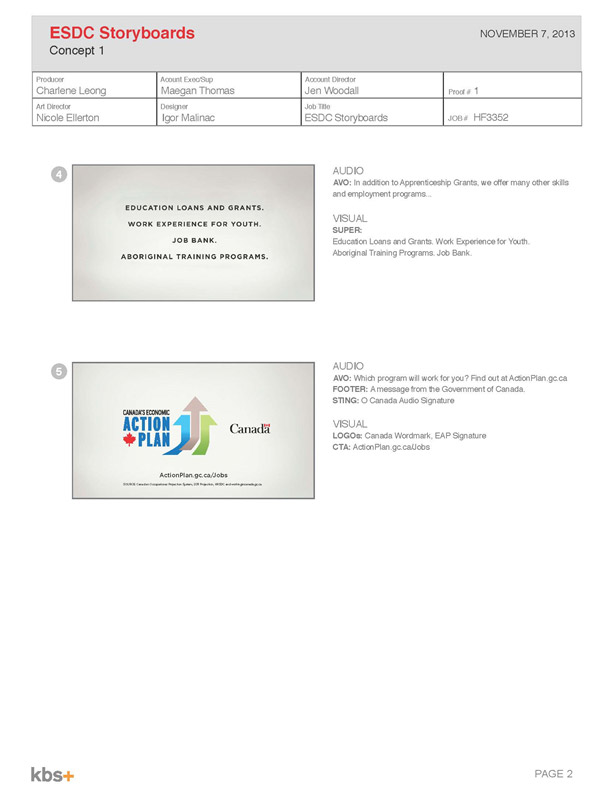
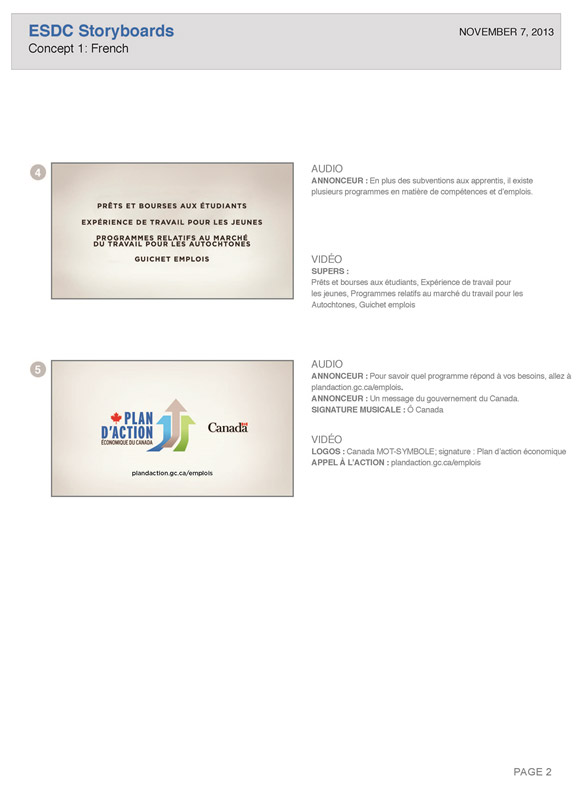
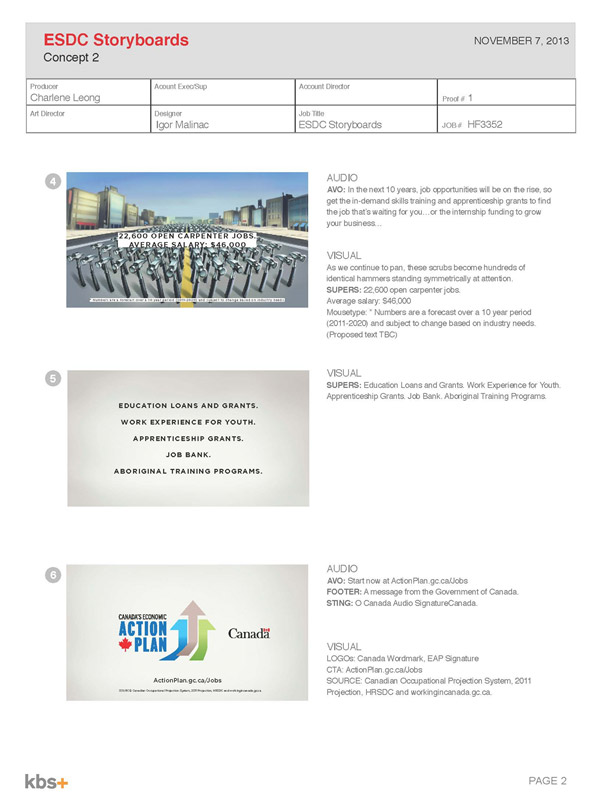
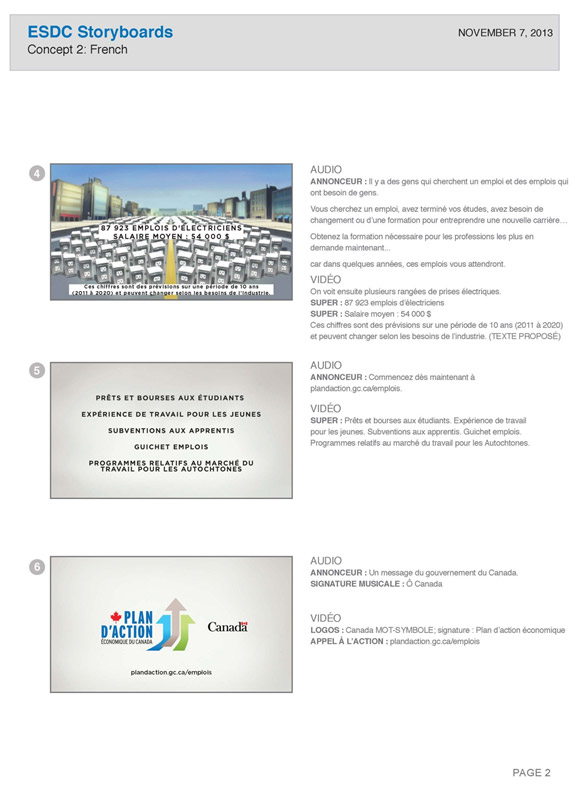
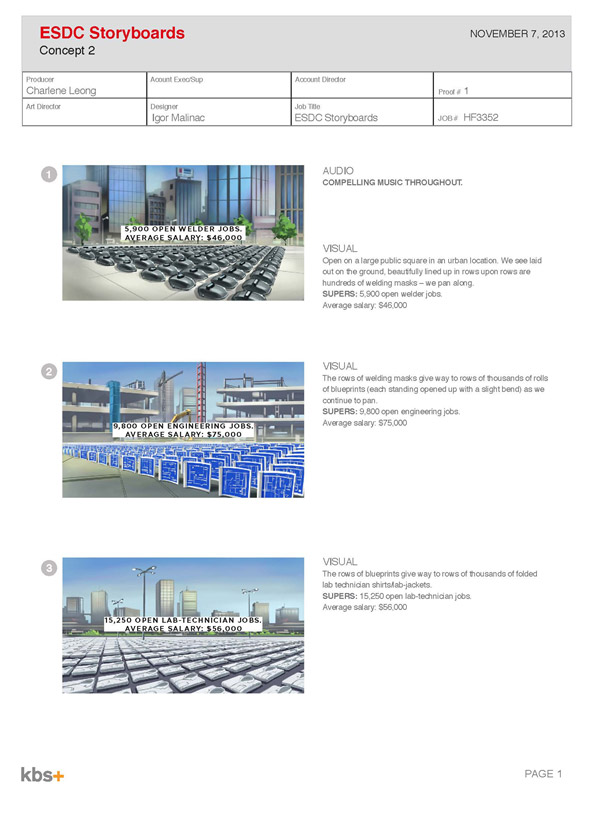
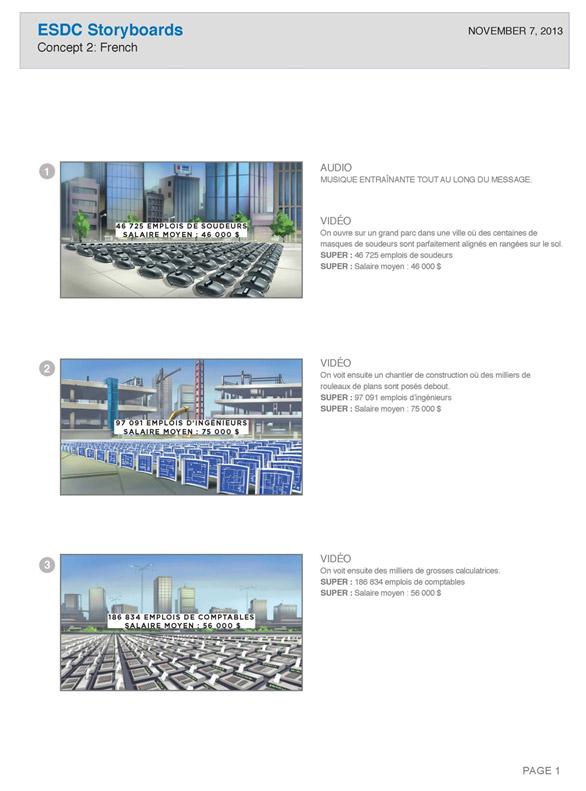
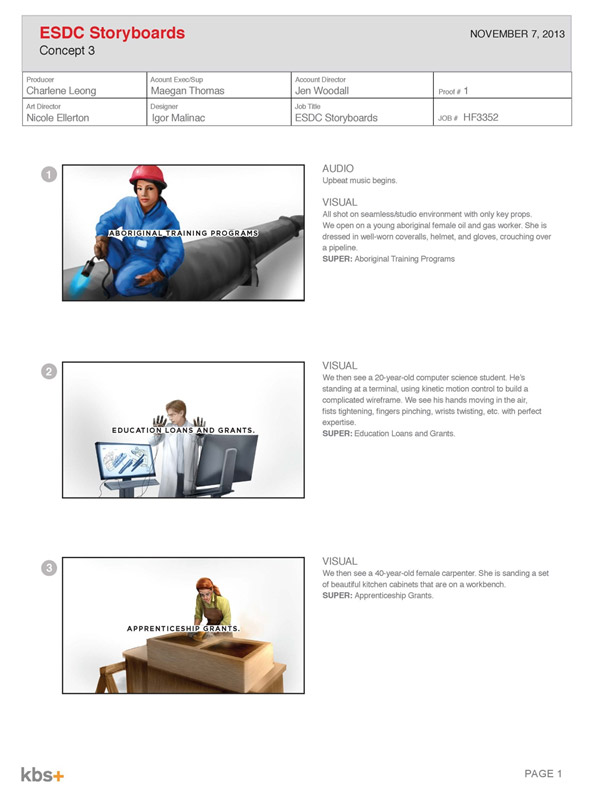
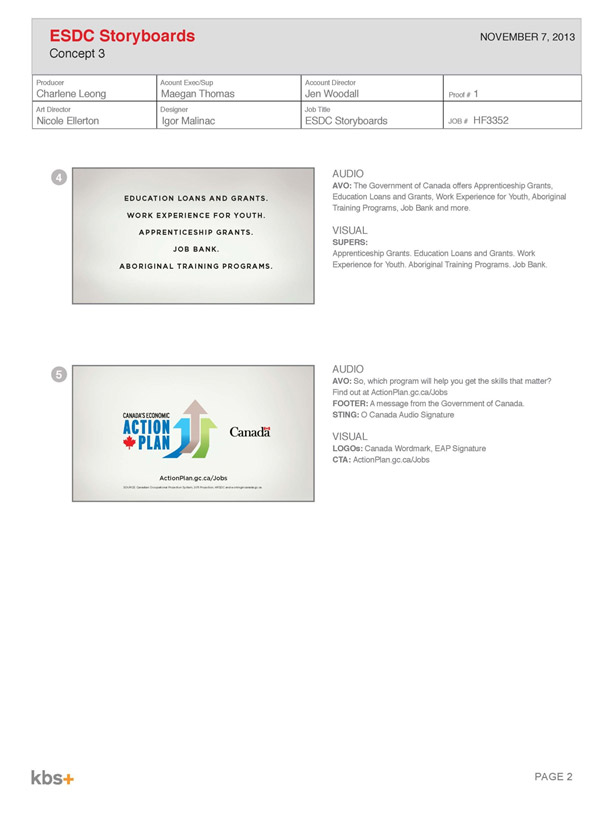
1 Groups with Brampton residents were conducted at a facility in Mississauga.